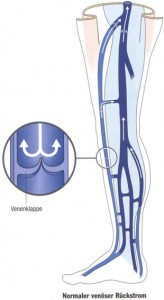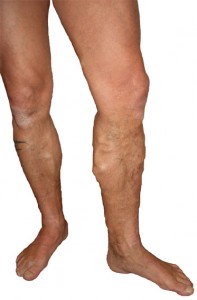Vein function
 Veins are tubular conduit systems with thin, elastic, mother-of-pearl-colored wall surfaces and are contractile due to delicate muscle fibers. The veins owe their color to the dark red, oxygen-poor blood, which is loaded with many waste products from cell metabolism. On the legs and arms they are equipped with valves, so-called Venous valves which only allow blood to flow in the direction of the heart.
Veins are tubular conduit systems with thin, elastic, mother-of-pearl-colored wall surfaces and are contractile due to delicate muscle fibers. The veins owe their color to the dark red, oxygen-poor blood, which is loaded with many waste products from cell metabolism. On the legs and arms they are equipped with valves, so-called Venous valves which only allow blood to flow in the direction of the heart.
When standing, a "passive" return flow of blood occurs in the veins, mainly through the mechanical pumping action of the leg muscles (muscle pump); when lying down, the blood literally "seeps" back to the heart by itself. Raising or flattening the legs relieves the strain on the legs, sitting on chairs and standing for long periods makes them heavy and tired.
Sitting on the floor, lying down, walking and running, cycling and other dynamic sports are healthy. Modern compression clothing and walking barefoot on soft surfaces optimize vein function. Alternating baths with alternating warm and cold water promote the veins' ability to contract and also train the return flow.
Veins initially form a network that later converges in branches to form trunks. The superficial venous system lies in and under the skin, outside the muscles and transports at best 10% of the returning blood. The deep venous system is embedded in the muscles and transports the majority of the extremity blood volume.
Development of varicose veins
 Varicositas or "The suffering with varicose veins"
Varicositas or "The suffering with varicose veins"
The mechanism of development - simply explained
Varicose veins (varices) occur sooner or later in almost everyone's life. They are caused by the effects of gravity when sitting or standing.
Disposition (Is it really heredity?)
We inherit from our parents and grandparents - but we only inherit the information: we inherit the tendency to get varicose veins, just as we inherit sun-sensitive skin. We have to acquire varicose veins in the same way as sunburn.
The real cause
Long periods of sitting and monotonous standing put pressure on the venous walls of the legs. The longer, the more often and the higher the blood has to be transported up to the heart, the greater the consequences: swollen, heavy, "tingling" legs become unpleasantly noticeable. They improve again when lying flat. Over the years, varicose veins develop due to premature slackening of the vein walls at the junction between the deep and superficial venous system.
What most people don't know:
Varicose veins do not develop first where you can see them, but at the junctions with the deep vein system.
People and heat balance
The body operating temperature of humans is 37°C. If we spend time in higher ambient temperatures or do more physical work, we are forced to release the excess heat. There are 3 "cooling mechanisms" available for this purpose:
1. the heat emitted by infrared light is comparable to the heat radiated by the sun or a brick oven. We feel this form of heat emission under our own comforter or in direct physical contact.
2. heat convection is the transfer of heat to passing air particles, as we experience the cooling effect of the wind. Humans invented the fan or ventilator for this purpose.
3. sweat secretion. The secretion of water onto the skin for evaporation, accompanied by the formation of evaporative cooling (perspiration, sweating).
 The heat produced by the internal organs (37°C) must be released via the body surface. The coolest areas are the tips of the body, i.e. fingers and the tip of the nose, which are at room temperature, while the skin temperature of the torso is 27 - 28°C.
The heat produced by the internal organs (37°C) must be released via the body surface. The coolest areas are the tips of the body, i.e. fingers and the tip of the nose, which are at room temperature, while the skin temperature of the torso is 27 - 28°C.
Heat regulation is based on the "onion skin principle" and adapts to the ambient temperature. At high temperatures, the blood vessels open up so that the heat can reach the surface, the skin turns red and the person becomes undressed. At lower temperatures, the blood vessels close, the skin turns white or blue and the person needs clothing for thermal protection.
